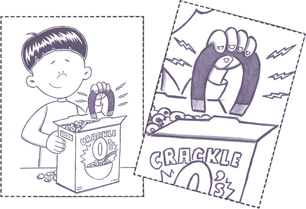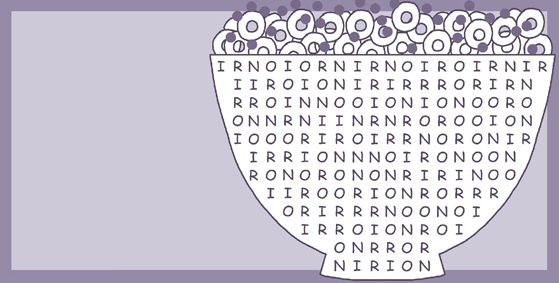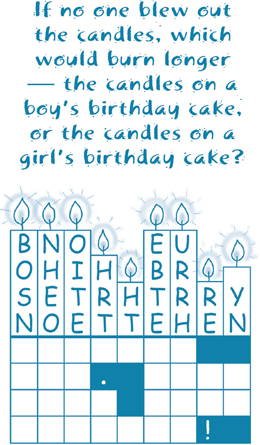Everything Kids' Magical Science Experiments Book (6 page)
Read Everything Kids' Magical Science Experiments Book Online
Authors: Tim Robinson
Tags: #epub, ebook

This toothpick can race across the surface of the water to find three answers to the riddle! Read the letters along each path from START to END. Magic!
Question: Is There Really Metal in Cereal?
KIDS' LAB LESSONS

Many dry breakfast cereals claim that they are “fortified” with vitamins and minerals. But what are these important additions to your breakfast, and are they all good for you? In this experiment, you will be examining various iron-enriched cereals. Iron is a metal that is commonly found in buildings, railroads, and tools. But it is also found in your blood. You will use a magnet to dig for this metal in a bowl of cereal and will do some comparisons between different brands to identify which brand contains the largest amount of iron.
It may seem a little strange to think about there being pieces of metal in your cereal, no matter how small they are, but it's true. Tiny pieces of iron are added to some cereals as a way to improve blood flow. You see, iron in your blood helps your body make hemoglobin. Hemoglobin is a protein that helps your blood carry oxygen to the rest of your body. People who have low iron levels in their blood are said to be anemic, and if their iron level drops too low, their bodies begin to show signs of tiredness and lethargy.
Some cereal manufacturers add tiny pieces of iron, called iron filings, to their cereal. If you were to ingest large pieces of iron, it would be dangerous for you. But these tiny pieces, almost invisible, and in small amounts, actually help your blood do its job of carrying oxygen throughout your body.
3 cups of Total brand iron-fortified cereal
(
NOTE:
Total makes a number of different kinds of cereal, but all claim to be iron-fortified, so choose one you are likely to want to eat after the experiment is complete.)
- Water
- Blender or large spoon
- Non-metallic bowl
- Strong bar magnet
- Sheet of white computer printer paper (optional)
EXPERIMENT NOTE:
A regular refrigerator magnet is not strong enough to attract the iron filings. You need to use a strong magnet, and one shaped like a bar will tend to be the most successful.

It might take a bit of magic to find the one time that the word IRON is spelled correctly in this bowl of cereal! Look up and down, and side-to-side.
- Pour the cereal into the blender or your bowl.
- Add enough water to cover the cereal.
- Either blend the mixture until the cereal is completely ground up, or mash the cereal for several minutes with the spoon.
- If you are using a blender, pour the contents of the pitcher into the non-metallic bowl. Rinse the bottom of the pitcher with water in order to capture all of the iron particles.
- Stir your magnet through the cereal mixture. Iron is heavier than water, so the filings will tend to sink to the bottom. Be patient and thorough with your stirring.
- Remove the magnet from the cereal and look for tiny black iron filings stuck to the magnet. They will look like pieces of stubble that you might find on a man's face if he hasn't shaved.
- To see the iron pieces more clearly, rub the magnet against a sheet of white paper, such as what you might find in a computer printer.
- Why should you use iron-fortified cereal to perform this experiment?

- What purpose do you think the water served in this experiment?

- Do you think your results would have been different had you used milk instead of water?

- How do you feel about eating cereal with pieces of iron in it? Are you more likely to eat cereal like this, less likely, or just as likely?

The brand of cereal you chose to test is not the only brand that has iron in it. Visit a grocery store and find other cereals that contain iron. Look to see if any of them provide “100% of the Recommended Daily Allowance” of iron. You can buy these cereals and do a comparison at home by repeating the experiment with different brands to see which have more iron than others.
You may also wish to compare the cereals that have iron in them with those that do not to see if there is anything these cereals have in common. For example, would you consider these iron-fortified cereals to be “healthy” cereals? Would you like to eat them yourself? Do you think they appeal more to adults or to kids? Part of the fun of doing science experiments is making up new questions and then finding ways to answer them.
Nearly everyone has had the chance to blow out a candle before. Whether it was on a birthday cake or lighting the room on a dark night, the candle probably went out rather easily as long as you blew directly on the flame. But imagine “blowing out” a candle without actually blowing directly on the flame. It can be done. And it's not magic, just good science.
Question: Can you “blow out” a candle without blowing on the flame?
- Small votive candle
- Short drinking glass with a flat base
- Large drinking glass
- ½ cup vinegar
- Baking soda
- Spoon
- 3â³ Ã 5â³ note card
- Adult helper

“Nature and Nature's laws lay hid in night, God said: âLet Newton be!,'and all was light.”
â
Alexander Pope, English poet
- Ask your helper to light the candle and carefully place it in the short glass so it sits flat on the bottom.
- Pour one heaping spoonful of baking soda into the large glass.
- Add the vinegar to the large glass. You should see a reaction almost immediately.
- Hold the large glass over the small one with the note card placed over its top so the foam doesn't spill out.
- Gently tip the large glass as if you were going to pour the vinegar into the smaller glass, but stop just as the liquid reaches the rim.
- Watch what happens to the candle.

To learn the answer to this silly science question, drop the letters into their proper place in the puzzle grid. The letters in each column fit in the spaces directly underneath that column, but in a different order! Black boxes are the spaces between the words.
